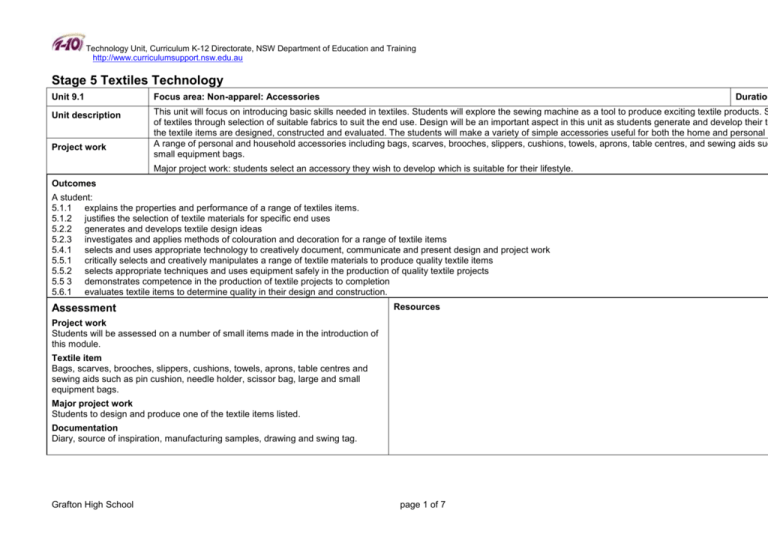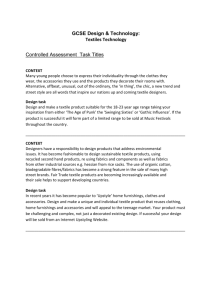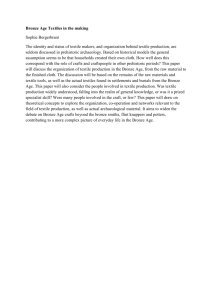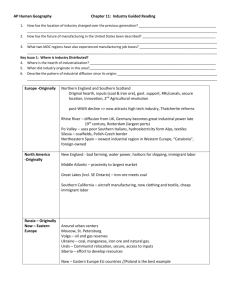textile technology textile technology
advertisement

Technology Unit, Curriculum K-12 Directorate, NSW Department of Education and Training http://www.curriculumsupport.nsw.edu.au Stage 5 Textiles Technology Unit 9.1 Focus area: Non-apparel: Accessories Unit description This unit will focus on introducing basic skills needed in textiles. Students will explore the sewing machine as a tool to produce exciting textile products. S of textiles through selection of suitable fabrics to suit the end use. Design will be an important aspect in this unit as students generate and develop their te the textile items are designed, constructed and evaluated. The students will make a variety of simple accessories useful for both the home and personal u A range of personal and household accessories including bags, scarves, brooches, slippers, cushions, towels, aprons, table centres, and sewing aids suc small equipment bags. Project work Duration Major project work: students select an accessory they wish to develop which is suitable for their lifestyle. Outcomes A student: 5.1.1 explains the properties and performance of a range of textiles items. 5.1.2 justifies the selection of textile materials for specific end uses 5.2.2 generates and develops textile design ideas 5.2.3 investigates and applies methods of colouration and decoration for a range of textile items 5.4.1 selects and uses appropriate technology to creatively document, communicate and present design and project work 5.5.1 critically selects and creatively manipulates a range of textile materials to produce quality textile items 5.5.2 selects appropriate techniques and uses equipment safely in the production of quality textile projects 5.5 3 demonstrates competence in the production of textile projects to completion 5.6.1 evaluates textile items to determine quality in their design and construction. Assessment Resources Project work Students will be assessed on a number of small items made in the introduction of this module. Textile item Bags, scarves, brooches, slippers, cushions, towels, aprons, table centres and sewing aids such as pin cushion, needle holder, scissor bag, large and small equipment bags. Major project work Students to design and produce one of the textile items listed. Documentation Diary, source of inspiration, manufacturing samples, drawing and swing tag. Grafton High School page 1 of 7 Technology Unit, Curriculum K-12 Directorate, NSW Department of Education and Training http://www.curriculumsupport.nsw.edu.au Students learn about: Students learn to: Teaching and learning activities Course introduction Course outline Course expectations Safety Levy Equipment requirements Evidence of learning Students successfully: complete the safety test. Teacher Introduces students to textile room and demonstrates safety guidelines. Discusses course outline and expectations. Student Observes safety issues in the textiles room Completes a safety test Project work Introduction to textiles Safe use and care of the sewing machine. Basic equipment and its safe use. Teacher Demonstrates safe use of sewing machine. Demonstrates threading of the machine. Student Identifies parts of machine and determines their function. Practices threading bobbin and machine. Sews samples to demonstrate their understanding of machine parts and their functions. Grafton High School page 2 of 7 Students successfully: thread the machine and complete samples to show their understanding of the machine parts. complete worksheets on machine parts and equipment. construct a simple calico bag for storage of textile projects and equipment. Technology Unit, Curriculum K-12 Directorate, NSW Department of Education and Training http://www.curriculumsupport.nsw.edu.au Students learn about: Students learn to: Teaching and learning activities Evidence of learning Project work Students successfully: complete a range of accessories to a high standard. record order of construction. Accessories projects The use of the sewing machine to produce a variety of small accessories. The construction of small projects such as – needle holder – pin cushions – scissor holder – scissor hanger – zip equipment bag – pot pourri bag – coat hanger cover – small cushion Teacher Supplies a variety of completed projects for students to select from. Demonstrates construction techniques needed to complete the projects. Provides fabric for completion of projects. Student Selects the most appropriate accessories for their own end use. Constructs a variety of accessories to improve their construction skills. Records how to construct the accessories. Grafton High School page 3 of 7 Technology Unit, Curriculum K-12 Directorate, NSW Department of Education and Training http://www.curriculumsupport.nsw.edu.au Students learn about: Performance of textile items end uses of textile items and performance criteria design features of textile items sequence of construction techniques of manufacture pattern shapes and markings. Fabric common fabric names, e.g. denim, organza, jersey, polar fleece, felt common fabric structures including – knitted – woven – non-woven types of fibres – natural – manufactured – fibre blends Grafton High School Students learn to: identify the performance criteria of textile items and link to end use sketch and label design features of the textile item outline the sequence of construction of textile items. identify techniques of manufacture of textile items draw the pattern shapes used to construct items and label pattern markings recognise and name fabrics used in textile items identify fabric structures using appropriate technology examine and/or test textile materials to identify the fibres used in the textile item. Teaching and learning activities Teacher Explains the term performance criteria and how it relates to the accessory they are designing. De-constructs an accessory eg bag for students to determine design features, sequencing of construction, manufacturing techniques and pattern shapes. Evidence of learning Student Sketches and labels design to be analysed. Determines the sequence of construction and the manufacturing techniques used during the deconstruction of the accessory. Uses a word processing program to draw and label the pattern pieces. Teacher Provides written notes to enable students to understand the introduction to the fabric study. Provides samples of fibres, yarns and fabrics. Organises experiments to enable students to identify various fibres, yarns and fabrics. Student Completes theory notes following discussion of fibres, yarns and fabrics. Collects a number of different fabrics and determines how they have been constructed. Conducts tests to identify fibres and records results. Analyses all fabrics used in individual project to determine fibre content, fabric construction and colouration method used. page 4 of 7 Student's drawings and sketches are able to communicate their understanding of the design features of the accessory. Students are able to analyse the accessory and determine the order of construction. Students are able to use this information to assist in the completion of their own individual project. Students are able to transfer knowledge of fibres, yarns and fabrics learnt in the introduction to analyse their own individual project. Students complete written documentation. Technology Unit, Curriculum K-12 Directorate, NSW Department of Education and Training http://www.curriculumsupport.nsw.edu.au Students learn about: Students learn to: Project work Designing sources of inspiration generating and developing ideas. communication and presentation of design idea selection of appropriate materials The practice of textile designers features of design in the construction of textile items factors affecting design – functional requirements – aesthetic aspects methods of applying colour and decoration such as – dyeing – beading – printing – applique – quilting – embroidery – handpainting Grafton High School Teaching and learning activities Teacher identify and creatively document sources of inspiration for the textile project generate and develop design ideas using sketching and rendering techniques use a variety of techniques to communicate and present the development of design ideas. identify aesthetic and functional performance criteria for textile materials of a textile item experiment with textile materials to determine which are most appropriate for a textile item. justify the selection of materials for a textile item identify features of design evident in construction across the focus areas outline functional and aesthetic aspects of the textile item Leads discussion on types of accessories students can design and produce. Provides resources to plan accessories design. Discusses suitable experiments available to determine appropriate materials. Explains the meaning of functional and aesthetic aspects of design. Provides information on methods of colouration and decoration that can be used. Student Completes a collage on a variety of accessories they have chosen. Sketches and labels design using freehand as well as computer-aided drawing. Identifies decoration techniques to be used and discusses methods to achieve this. Determines materials to be used in the construction. Prepares pattern pieces for the design, which are clearly labelled. Plans the order of construction. Determines the functional and aesthetic aspects of design as applied to their individual project. investigate and describe at least one technique of colouration and decoration page 5 of 7 Evidence of learning Students successfully: complete a collage to assist in the planning of the project. present accurate well labelled designs. select materials and equipment required. apply knowledge of functional and aesthetic aspects in the planning of the project. include one form of decoration in the design. Technology Unit, Curriculum K-12 Directorate, NSW Department of Education and Training http://www.curriculumsupport.nsw.edu.au Students learn about: Producing management of project work calculating textile requirements considering spatial concepts sequencing of construction for the textile item. safe use of a variety of textile equipment techniques such as – construction and decoration labelling requirements of textile items swing tag Students learn to: plan and organise the stages involved in the design and production of a textile item calculate quantity and cost of requirements for a textile item plan and document a procedure for the construction of a textile item using a word-processing application select and safely use textile equipment to construct a quality textile item experiment with, select and use techniques to ensure quality textile items identify the labelling requirements of a range of textile items design and produce a product label and swing tag for textile items produced in project work Teaching and learning activities Evidence of learning Teacher Students: produce well thought out construction plans. record an informative diary. purchase appropriate materials after successfully investigating requirements. produce the accessory to satisfy the performance criteria. present a quality project and appropriate written documentation. present appropriate labelling and swing tag. Student Grafton High School Uses ready-made accessories to show students a variety of designs. De-constructs some accessories for students to determine the most suitable construction techniques. Discusses suitable materials and construction techniques with each individual student. Provides written notes on a variety of construction techniques. Gives guidance throughout the designing and construction of the accessory. Records action and time plan in flow chart form. Writes a detailed entry in a diary of work each lesson and includes self-evaluation. Demonstrates the selection and safe use of textiles equipment. Investigates the purchase and cost of textile requirements needed. Conducts experiments to determine the most suitable technique to be used. Observes labels used on ready-made clothing and accessories. Researches the legal requirements of labels for textile items. Designs and produces a product label and swing tag for the accessory produced. page 6 of 7 Technology Unit, Curriculum K-12 Directorate, NSW Department of Education and Training http://www.curriculumsupport.nsw.edu.au Students learn about: Evaluating evaluation of the quality of textile items in relation to – design – functional requirements – aesthetic aspects – construction – fabric selection – notions used Grafton High School Students learn to: establish criteria for evaluation of a textiles item evaluate the textile items during designing and producing using such techniques as selfevaluation and peer-evaluation use feedback from evaluation to modify project work and ensure a quality result Teaching and learning activities Teacher Develops a checklist of criteria to evaluate the finished design. Student Evaluates the finished product using self and peer evaluation. Completes evaluation throughout the design and construction of the project. page 7 of 7 Evidence of learning Students develop a checklist to assess the finished product. Students participate in peer and self-evaluation to assist in assessing the project and evaluating strengths and weaknesses.






